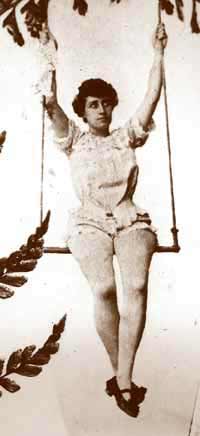
The captivating American aerialist Leila Adair, whose attempt to fly in Masterton park ended in flames and recriminations.
The King and Queen of the Air
The first balloonist in New Zealand was an American, Professor Baldwin, who made the first New Zealand balloon flight in Dunedin in early 1889, using coal gas to inflate his oiled-silk balloon. He was followed by a number of hot air balloonists, but it wasn’t until June 1894 that Masterton was included on the itinerary of these travelling performers.
Masterton’s first balloonist was a graceful young American woman, Leila Adair, the self–styled “Aerial Queen.” Leila travelled New Zealand, performing acrobatic acts on a trapeze bar suspended under the inflated balloon, before dropping gracefully from the bar, and drifting to earth by parachute.
On Leila’s first New Zealand ascent, in Auckland, things went a little awry when the balloon was blown out over the channel between Auckland and Rangitoto Island. Not wanting to parachute into the sea, Leila rode the balloon down until just metres from the waves. She then dropped into the sea, suspended by a life belt until she could be rescued by steamship.
A Te Aroha ascent ended with a Waihi descent. In Cambridge she landed in the tops of some tall poplars. In Hamilton the balloon burst in mid-air while her Wanganui ascent was even more spectacular. She was unable to get sufficient buoyancy to inflate the balloon and it flew on a perilous journey through flagstaffs and chimneys before she was dumped unceremoniously in a fig tree.
Details of these adventures were reported in the local newspapers so the Aerial Queen’s arrival in Masterton was awaited with great anticipation. A huge crowd paid their shilling entrance fee and congregated in Masterton Park to watch what they were informed would be the “greatest sensational feat ever performed in these parts.”
Leila and her brother arrived and the dramatic inflation commenced. People stood open-mouthed as the balloon slowly filled and those helping to hold the balloon were jolted as it rocked from side to side. Soon a small whiff of smoke was seen escaping from the top of the balloon and before long it became a large whiff of smoke, then the whole balloon caught fire.
Leila Adair sat in her cab watching the destruction. Her brother did his best to help salvage what remained but it was a hopeless case. The balloon was gone.
Leila’s brother stood and addressed the crowd, telling them that the balloon was beyond repair, and that it was going to cost £145 to replace. He promised he and Leila would have a new balloon built in Wellington and would be back the following Saturday to give a free exhibition to all those who had paid.
Although she did have a new balloon made, a balloon she toured other parts of New Zealand with, Leila never returned to Masterton.
It wasn’t to be until 1908 that Masterton saw its ascent, and it wasn’t the ‘Aerial Queen’ – it was the “Aerial King”.
Noah Ezra Jonasson, Christchurch-born of Danish parents made two ascents, the first on 2 April, 1908, from the Showgrounds in Dixon Street, now the Cameron and Soldier’s Memorial Park. A very large crowd gathered to watch his display, excited when the balloon was cast adrift and it shot up into the air with the Captain performing “clever gymnastic evolutions” for the crowd. The balloon did not travel very far, nor ascend very high, however, and the Captain parachuted down into a paddock behind Bunny’s Bush, at the end of McKenna Street.
His next ascent, a week later, was much more successful, the balloon rapidly rising then catching the gentle southerly breeze to drift over the town. Jonasson alighted from his parachute between Cole and Essex Streets, while the aerialist-free balloon continued over the town, eventually landing in Oxford Street.
Jonasson, unlike many other early aerialists, lived to an old age, dying in Thames in 1959. He is said to have undertaken his last parachute jump, from an aeroplane this time, in the 1930s. He broke a leg as he landed.
